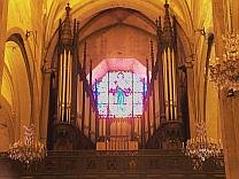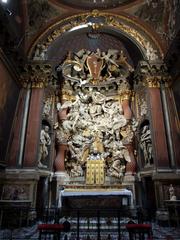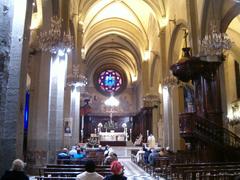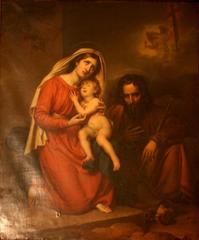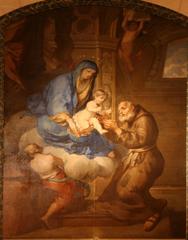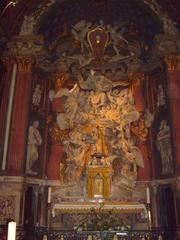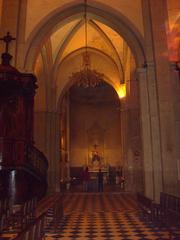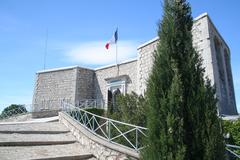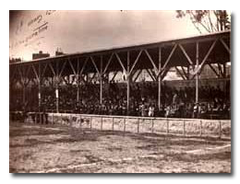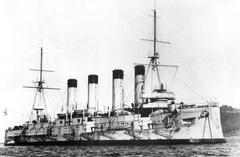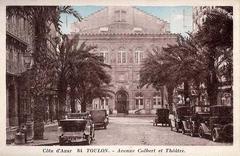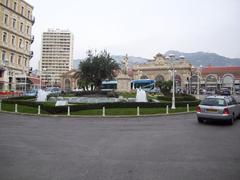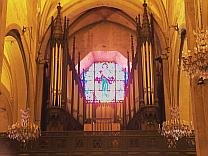
Comprehensive Guide to Visiting Cathédrale Sainte-Marie-de-la-Seds, Toulon, France
Date: 19/07/2024
Introduction
Cathédrale Sainte-Marie-de-la-Seds, commonly known as Toulon Cathedral, is an architectural marvel and a beacon of historical significance located in the heart of Toulon, France. Dating back to the 11th century, the cathedral has witnessed numerous phases of expansion and renovation, each reflecting the prevailing architectural styles of the time. Initially built as a Romanesque church, it evolved through Gothic, Renaissance, and Baroque influences, making it a unique blend of styles that stand as a testament to the region’s rich cultural heritage (source). The cathedral has not only served as a spiritual center but also played pivotal roles in various historical events, including the tumultuous period of the French Revolution and the destructive bombings of World War II (source). Whether you’re an architecture enthusiast, history buff, or a casual tourist, Cathédrale Sainte-Marie-de-la-Seds offers an enriching experience that encapsulates the essence of Toulon’s past and present.
Table of Contents
- Introduction
- History of Cathédrale Sainte-Marie-de-la-Seds
- Architectural Highlights
- Visitor Information
- Special Events and Guided Tours
- Conclusion
- FAQ
History of Cathédrale Sainte-Marie-de-la-Seds
Early Beginnings
The origins of Cathédrale Sainte-Marie-de-la-Seds trace back to the 11th century. The initial structure was a modest Romanesque church built around 1096. This early church was constructed under the auspices of the Bishop of Toulon, who sought to establish a significant religious edifice in the region. The Romanesque style, characterized by semi-circular arches and robust structure, was prevalent during this period, reflecting the architectural trends of medieval Europe.
Medieval Expansion
The 13th century marked a significant phase of expansion for the cathedral. As Toulon grew in importance as a maritime and military hub, the need for a larger and more imposing cathedral became evident. The church was expanded to accommodate the growing population and the increasing number of pilgrims visiting the site. This expansion included the addition of a nave and side aisles, which were designed in the Gothic style, a departure from the original Romanesque architecture. The Gothic style, with its pointed arches, ribbed vaults, and flying buttresses, allowed for taller and more light-filled structures, enhancing the cathedral’s grandeur.
Renaissance and Baroque Influences
The 17th century brought further modifications to the cathedral, reflecting the Renaissance and Baroque influences that were sweeping across Europe. In 1654, Bishop Gilles de Savoie initiated a significant renovation project. This period saw the addition of a new façade, designed in the Baroque style, which was characterized by dramatic expressions, grandeur, and detailed ornamentation. The façade’s intricate sculptures and decorative elements were intended to inspire awe and reflect the glory of the Catholic Church.
The French Revolution and Its Aftermath
The French Revolution (1789-1799) had a profound impact on many religious institutions across France, and Cathédrale Sainte-Marie-de-la-Seds was no exception. During the revolution, the cathedral was repurposed as a Temple of Reason, a common practice aimed at de-Christianizing the country. Many of the cathedral’s religious artifacts and artworks were destroyed or looted during this tumultuous period. However, the cathedral was restored to its original purpose in the early 19th century, following the Concordat of 1801, which re-established the Catholic Church in France.
19th and 20th Century Restorations
The 19th century saw extensive restoration efforts aimed at preserving and enhancing the cathedral’s historical and architectural significance. In 1822, the cathedral was officially designated as a monument historique by the French government, recognizing its cultural and historical importance. Restoration projects during this period focused on repairing damage from the revolution and previous centuries of wear and tear. These efforts included the restoration of the Baroque façade and the addition of new stained glass windows, which depicted scenes from the Bible and the lives of saints.
The 20th century brought further challenges and restorations. During World War II, Toulon was heavily bombed, and the cathedral sustained significant damage. Post-war restoration efforts were undertaken to repair the structural damage and restore the cathedral to its former glory. These efforts were guided by a commitment to preserving the historical integrity of the building while incorporating modern techniques and materials.
Architectural Highlights
One of the most striking features of Cathédrale Sainte-Marie-de-la-Seds is its blend of architectural styles, reflecting the various periods of its construction and renovation. The Romanesque elements, such as the semi-circular arches and sturdy columns, are complemented by the Gothic features, including the pointed arches and ribbed vaults. The Baroque façade, with its elaborate sculptures and decorative elements, adds a layer of grandeur and artistic expression.
The interior of the cathedral is equally impressive, with its high vaulted ceilings, intricate woodwork, and beautiful stained glass windows. The nave, with its soaring arches and spacious layout, creates a sense of awe and reverence. The side chapels, each dedicated to different saints, are adorned with religious artworks and sculptures, providing a glimpse into the rich religious heritage of the region.
Visitor Information
Visiting Hours
Cathédrale Sainte-Marie-de-la-Seds is open to visitors daily. The typical visiting hours are from 8:00 AM to 7:00 PM. However, it is advisable to check the cathedral’s official website or contact the administration for any changes in the schedule, especially during holidays and special events.
Tickets
Entry to the cathedral is generally free of charge. However, donations are encouraged to support the ongoing maintenance and preservation of this historic site. Special guided tours may have a fee, and it is recommended to book these in advance through the cathedral’s official website.
Travel Tips
- Best Time to Visit: The cathedral is less crowded in the early morning and late afternoon. Weekdays are generally quieter than weekends.
- Photography: Photography is allowed inside the cathedral, but flash photography is prohibited to preserve the artworks.
- Accessibility: The cathedral is accessible to visitors with mobility challenges. There are ramps and designated areas for wheelchair users.
- Nearby Attractions: The cathedral is located in the heart of Toulon, making it easy to explore nearby attractions such as the Toulon Opera House, the National Maritime Museum, and the vibrant local markets.
Special Events and Guided Tours
Cathédrale Sainte-Marie-de-la-Seds hosts various religious and cultural events throughout the year. These include special masses, concerts, and art exhibitions. Guided tours are available and provide a deeper insight into the cathedral’s history, architecture, and significance. These tours can be booked through the cathedral’s official website or at the visitor center.
Conclusion
Cathédrale Sainte-Marie-de-la-Seds is more than just a historical monument; it is a living testament to the rich cultural and religious heritage of Toulon. Whether you are visiting for its historical significance, architectural beauty, or spiritual ambiance, the cathedral offers a unique and enriching experience. Plan your visit today and immerse yourself in the history and grandeur of this remarkable site.
For more detailed information on the cathedral’s history, architectural features, and visitor guidelines, visit the official Toulon Cathedral website.
FAQ
-
What are the visiting hours for Toulon Cathedral?
- The cathedral is generally open from 8:00 AM to 7:00 PM daily.
-
How much do tickets cost for Toulon Cathedral?
- Entry is free, but donations are encouraged. Special guided tours may have a fee.
-
What are some nearby attractions?
- Nearby attractions include the Toulon Opera House, the National Maritime Museum, and local markets.
-
Is the cathedral accessible for visitors with disabilities?
- Yes, the cathedral offers ramps and designated areas for wheelchair users.
References
- A Comprehensive Guide to Cathédrale Sainte-Marie-de-la-Seds - History, Visitor Tips, and More, 2024. (source)
- Visiting Cathédrale Sainte-Marie-de-la-Seds in Toulon - History, Tickets, and Tips, 2024. (source)
- Visitor Tips for Cathédrale Sainte-Marie-de-la-Seds in Toulon - Hours, Tickets, and More, 2024. (source)
